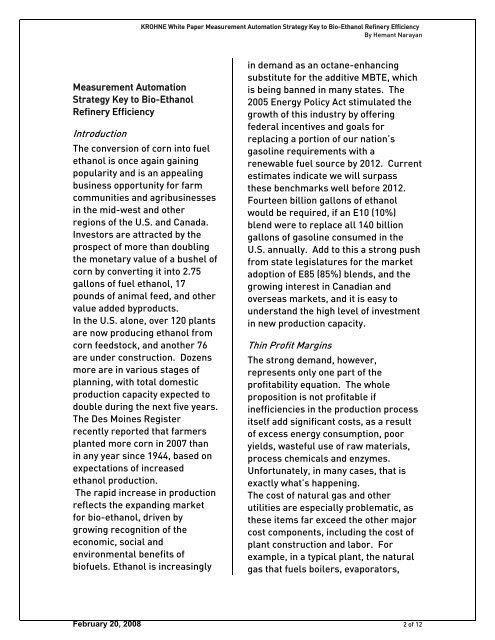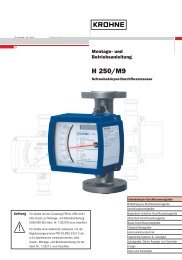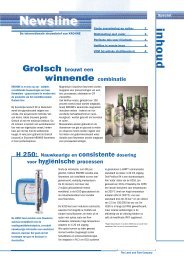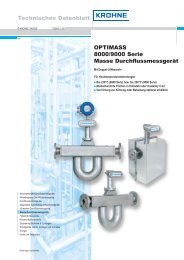Measurement Automation Strategy: Key to Bio-Ethanol ... - Krohne
Measurement Automation Strategy: Key to Bio-Ethanol ... - Krohne
Measurement Automation Strategy: Key to Bio-Ethanol ... - Krohne
Create successful ePaper yourself
Turn your PDF publications into a flip-book with our unique Google optimized e-Paper software.
<strong>Measurement</strong> <strong>Au<strong>to</strong>mation</strong><br />
<strong>Strategy</strong> <strong>Key</strong> <strong>to</strong> <strong>Bio</strong>-<strong>Ethanol</strong><br />
Refinery Efficiency<br />
KROHNE White Paper <strong>Measurement</strong> <strong>Au<strong>to</strong>mation</strong> <strong>Strategy</strong> <strong>Key</strong> <strong>to</strong> <strong>Bio</strong>-<strong>Ethanol</strong> Refinery Efficiency<br />
By Hemant Narayan<br />
Introduction<br />
The conversion of corn in<strong>to</strong> fuel<br />
ethanol is once again gaining<br />
popularity and is an appealing<br />
business opportunity for farm<br />
communities and agribusinesses<br />
in the mid-west and other<br />
regions of the U.S. and Canada.<br />
Inves<strong>to</strong>rs are attracted by the<br />
prospect of more than doubling<br />
the monetary value of a bushel of<br />
corn by converting it in<strong>to</strong> 2.75<br />
gallons of fuel ethanol, 17<br />
pounds of animal feed, and other<br />
value added byproducts.<br />
In the U.S. alone, over 120 plants<br />
are now producing ethanol from<br />
corn feeds<strong>to</strong>ck, and another 76<br />
are under construction. Dozens<br />
more are in various stages of<br />
planning, with <strong>to</strong>tal domestic<br />
production capacity expected <strong>to</strong><br />
double during the next five years.<br />
The Des Moines Register<br />
recently reported that farmers<br />
planted more corn in 2007 than<br />
in any year since 1944, based on<br />
expectations of increased<br />
ethanol production.<br />
The rapid increase in production<br />
reflects the expanding market<br />
for bio-ethanol, driven by<br />
growing recognition of the<br />
economic, social and<br />
environmental benefits of<br />
biofuels. <strong>Ethanol</strong> is increasingly<br />
in demand as an octane-enhancing<br />
substitute for the additive MBTE, which<br />
is being banned in many states. The<br />
2005 Energy Policy Act stimulated the<br />
growth of this industry by offering<br />
federal incentives and goals for<br />
replacing a portion of our nation’s<br />
gasoline requirements with a<br />
renewable fuel source by 2012. Current<br />
estimates indicate we will surpass<br />
these benchmarks well before 2012.<br />
Fourteen billion gallons of ethanol<br />
would be required, if an E10 (10%)<br />
blend were <strong>to</strong> replace all 140 billion<br />
gallons of gasoline consumed in the<br />
U.S. annually. Add <strong>to</strong> this a strong push<br />
from state legislatures for the market<br />
adoption of E85 (85%) blends, and the<br />
growing interest in Canadian and<br />
overseas markets, and it is easy <strong>to</strong><br />
understand the high level of investment<br />
in new production capacity.<br />
Thin Profit Margins<br />
The strong demand, however,<br />
represents only one part of the<br />
profitability equation. The whole<br />
proposition is not profitable if<br />
inefficiencies in the production process<br />
itself add significant costs, as a result<br />
of excess energy consumption, poor<br />
yields, wasteful use of raw materials,<br />
process chemicals and enzymes.<br />
Unfortunately, in many cases, that is<br />
exactly what’s happening.<br />
The cost of natural gas and other<br />
utilities are especially problematic, as<br />
these items far exceed the other major<br />
cost components, including the cost of<br />
plant construction and labor. For<br />
example, in a typical plant, the natural<br />
gas that fuels boilers, evapora<strong>to</strong>rs,<br />
February 20, 2008 2 of 12
















